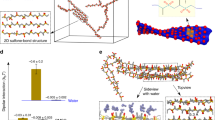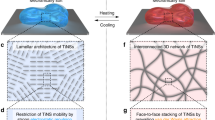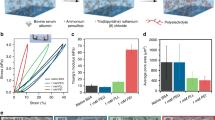Abstract
Stimuli-sensitive polymer hydrogels, which swell or shrink in response to changes in the environmental conditions, have been extensively investigated and used as ‘smart’ biomaterials and drug-delivery systems1, 2. Most of these responsive hydrogels are prepared from a limited number of synthetic polymers and their derivatives, such as copolymers of (meth)acrylic acid, acrylamide and N-isopropyl acrylamide3,4,5,6,7,8,9,10,11,12. Water-soluble synthetic polymers have also been crosslinked with molecules of biological origin, such as oligopeptides13 and oligodeoxyribonucleotides14, or with intact native proteins15. Very often there are several factors influencing the relationship between structure and properties in these systems, making it difficult to engineer hydrogels with specified responses to particular stimuli. Here we report a hybrid hydrogel system assembled from water-soluble synthetic polymers and a well-defined protein-folding motif, the coiled coil. These hydrogels undergo temperature-induced collapse owing to the cooperative conformational transition of the coiled-coil protein domain. This system shows that well-characterized water-soluble synthetic polymers can be combined with well-defined folding motifs of proteins in hydrogels with engineered volume-change properties16, 17.
This is a preview of subscription content, access via your institution
Access options
Subscribe to this journal
Receive 51 print issues and online access
$199.00 per year
only $3.90 per issue
Buy this article
- Purchase on Springer Link
- Instant access to full article PDF
Prices may be subject to local taxes which are calculated during checkout



Similar content being viewed by others
References
Langer, R. Drug delivery and targeting. Nature 392 (suppl.), 5–10 (1998).
Peppas, N. A. Hydrogels and drug delivery. Curr. Opin. Colloid Interface Sci. 2, 531–537 (1997).
Kopeček, J., Vacík, J. & Lím, D. Permeability of membranes containing ionogenic group. J. Polym. Sci. A-1 9,, 2801–2815 (1971).
Suzuki, A. & Tanaka, T. Phase transition in polymer gels induced by visible light. Nature 346, 345–347 (1990).
Kokufuta, E., Zhang, Y. Q. & Tanaka, T. Saccharide-sensitive phase transition of a lectin-loaded gel. Nature 351, 302–304 (1991).
Kwon, I. C., Bae, Y. H. & Kim, S. W. Electrically erodible polymer gel for controlled release of drugs. Nature 354, 291–293 (1991).
Osada, Y., Okuzaki, H. & Hori, H. Apolymer gel with electrically driven motility. Nature 355, 242–244 (1992).
Chen, G. & Hoffman, A. S. Graft copolymers that exhibit temperature-induced phase transitions over a wide range of pH. Nature 373, 49–52 (1995).
Yoshida, R. et al. Comb-type grafted hydrogels with rapid de-swelling response to temperature changes. Nature 374, 240–242 (1995).
Holtz, J. H. & Asher, S. A. Polymerized colloidal crystal hydrogel films as intelligent chemical sensing materials. Nature 389, 829–832 (1997).
Hu, Z., Chen, Y., Wang, C., Zheng, Y. & Li, Y. Polymer gels with engineered environmentally responsive surface patterns. Nature 393, 149–152 (1998).
Kiser, P. F., Wilson, G. & Needham, D. Asynthetic mimic of the secretory granule for drug delivery. Nature 394, 459–462 (1998).
Šubr, V., Duncan, R. & Kopeček, J. Release of macromolecules and daunomycin from hydrophilic gels containing enzymatically degradable bonds. J. Biomater. Sci. Polym. Edn 1, 261–278 (1990).
Nagahara, S. & Matsuda, T. Hydrogel formation via hybridization of oligonucleotides derivatized in water-soluble vinyl polymers. Polym. Gels Networks 4, 111–127 (1996).
Obaidat, A. A. & Park, K. Characterization of glucose dependent gel-sol phase transition of the polymeric glucose-concanavalin A hydrogel system. Pharm. Res. 13, 989–995 (1996).
Wang, C., Stewart, R. J. & Kopeček, J. De novo design of hybrid hydrogels: water soluble polymers crosslinked by coiled-coil protein domains. Proc. Int. Symp. Controlled Release Bioact. Mater. 25, 54–55 (1998).
Wang, C., Stewart, R. J. & Kopeček, J. Tailor-made hybrid hydrogels: synthetic macromolecules crosslinked by coiled-coil protein domains. ACS Polym. Preprints 39, 194–195 (1998).
Lupas, A. Coiled coils: new structures and new functions. Trends Biochem. Sci. 21, 375–382 (1996).
O'Shea, E. K., Rutkowski, R. & Kim, P. S. Mechanism of specificity in the Fos-Jun oncoprotein heterodimer. Cell 68, 699–708 (1992).
Harbury, P. B., Zhang, T., Kim, P. S. & Alber, T. Aswitch between two-, three-, and four-stranded coiled coils in GCN4 leucine zipper mutants. Science 262, 1401–1407 (1993).
Su, J. Y., Hodges, R. S. & Kay, C. M. Effect of chain length on the formation and stability of synthetic α-helical coiled coils. Biochemistry 33, 15501–15510 (1994).
Gonzalez, L. J, Plecs, J. J. & Alber, T. An engineered allosteric switch in leucine-zipper oligomerization. Nature Struct. Biol. 3, 510–515 (1996).
Hochuli, H. Purification of recombinant proteins with metal chelate adsorbent. Genet. Eng. 12, 87–98 (1990).
Ng, K., Pack, D. W., Sasaki, D. Y. & Arnold, F. H. Engineered protein-lipid interactions: targeting of histidine-tagged proteins to metal-chelating lipid monolayers. Langmuir 11, 4048–4055 (1995).
Ho, C. H., Limberis, L., Caldwell, K. D. & Stewart, R. J. Ametal-chelating pluronic for immobilization of histidine-tagged proteins at interfaces: immobilization of firefly luciferase on polystyrene beads. Langmuir 14, 3889–3894 (1998).
Yang, J. T., Laymon, R. A. & Goldstein, L. S. B. Athree-domain structure of kinesin heavy chain revelaed by DNA sequence and microtubule binding analyses. Cell 56, 879–889 (1989).
Graddis, T. J., Myszka, D. G. & Chaiken, I. M. Controlled formation of model homo- and heterodimer coiled coil polypeptides. Biochemistry 32, 12664–12671 (1993).
Hirokawa, N. et al. Submolecular domains of bovine brain kinesin identified by electron microscopy and monoclonal antibody decoration. Cell 56, 867–878 (1989).
Petka, W. A., Harden, J. L., McGrath, K. P., Wirtz, D. & Tirrell, D. A. Reversible hydrogels from self-assembling artificial proteins. Science 281, 389–392 (1998).
Aggeli, A. et al. Responsive gels formed by the spontaneous self-assembly of peptides into polymeric β-sheet tapes. Nature 386, 259–262 (1997).
Acknowledgements
This work was supported in part by the Center for Biopolymers at Interfaces (CBI) and the University of Utah Research Foundation.
Author information
Authors and Affiliations
Corresponding author
Rights and permissions
About this article
Cite this article
Wang, C., Stewart, R. & KopeČek, J. Hybrid hydrogels assembled from synthetic polymers and coiled-coil protein domains. Nature 397, 417–420 (1999). https://doi.org/10.1038/17092
Received:
Accepted:
Issue Date:
DOI: https://doi.org/10.1038/17092
This article is cited by
-
Hyaluronic Acid Fibres in Solid Phase Peptide Synthesis — Their Properties, Morphology and Stability
Fibers and Polymers (2020)
-
Injectable hydrogels delivering therapeutic agents for disease treatment and tissue engineering
Biomaterials Research (2018)
-
Polypeptide Thermogels as Three-Dimensional Scaffolds for Cells
Tissue Engineering and Regenerative Medicine (2018)
Comments
By submitting a comment you agree to abide by our Terms and Community Guidelines. If you find something abusive or that does not comply with our terms or guidelines please flag it as inappropriate.



